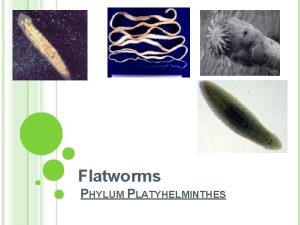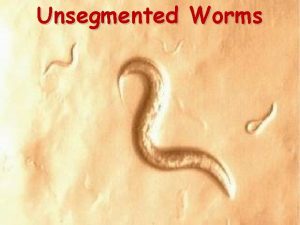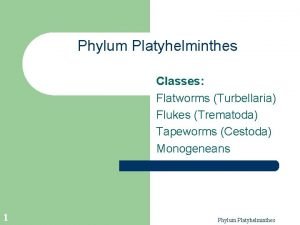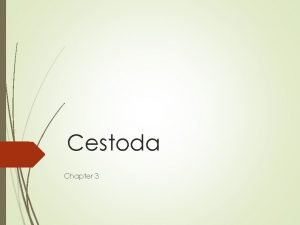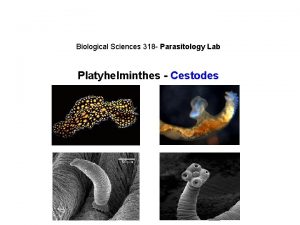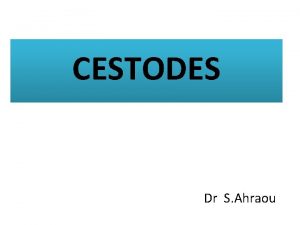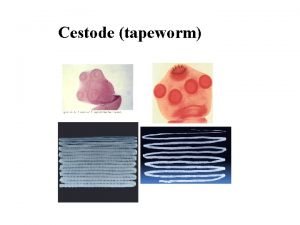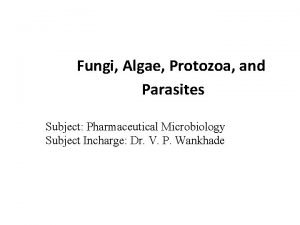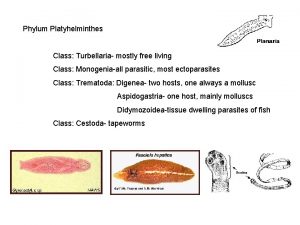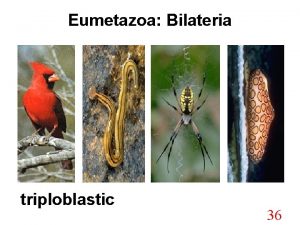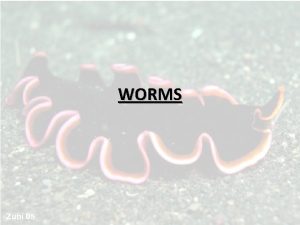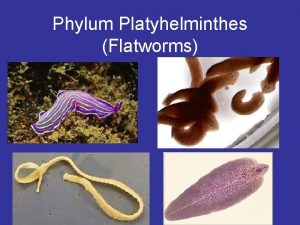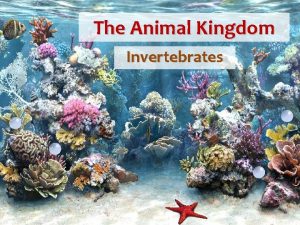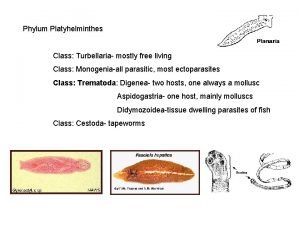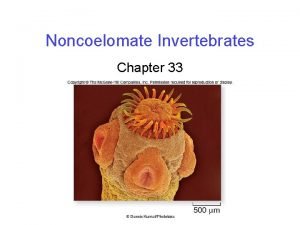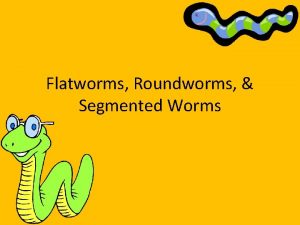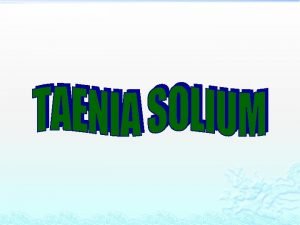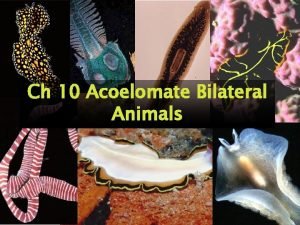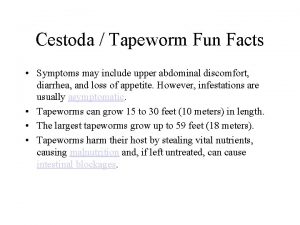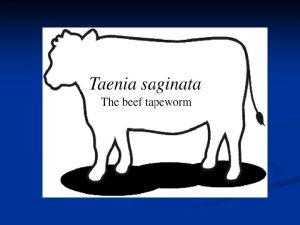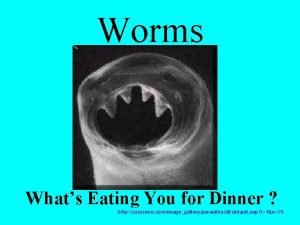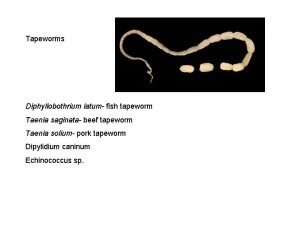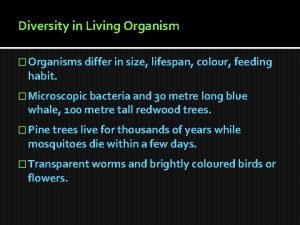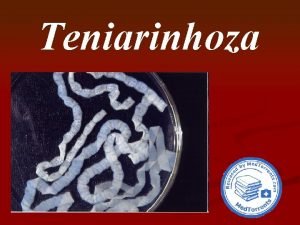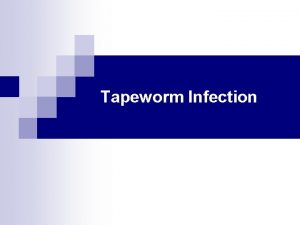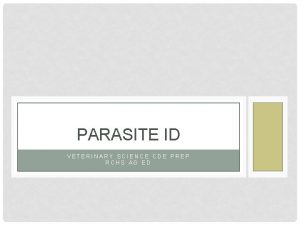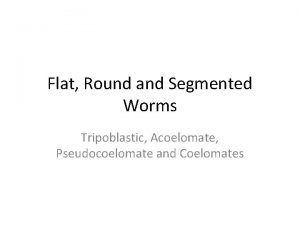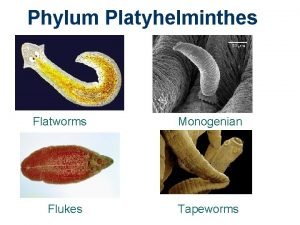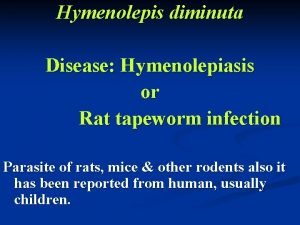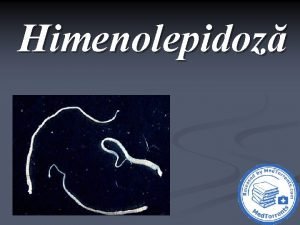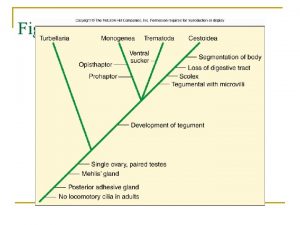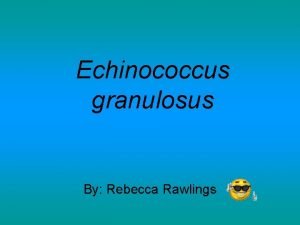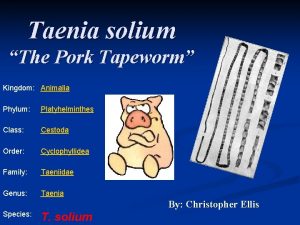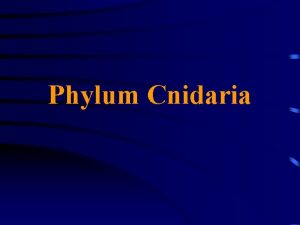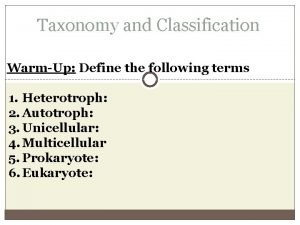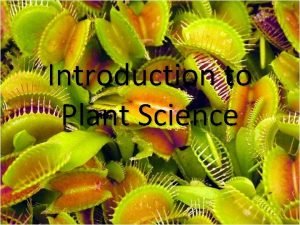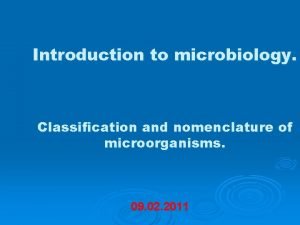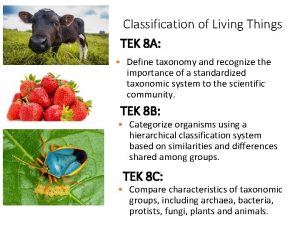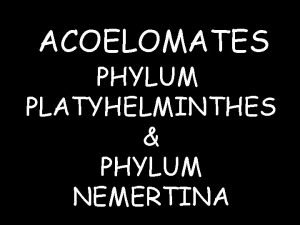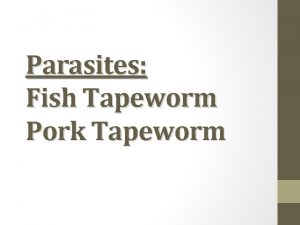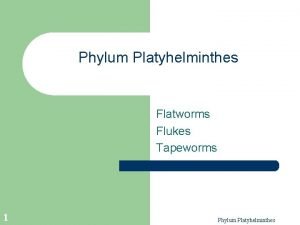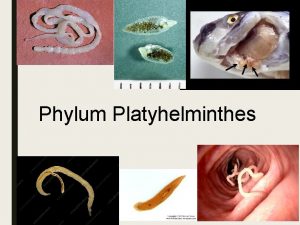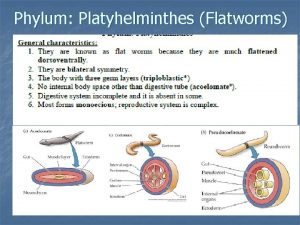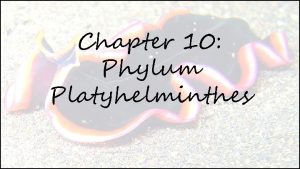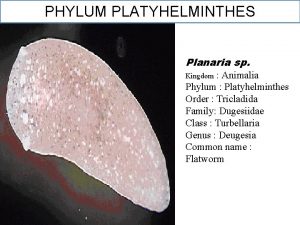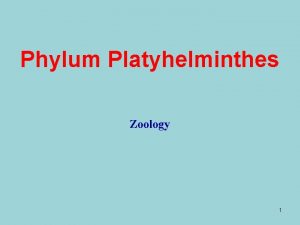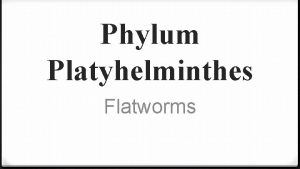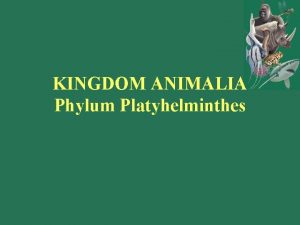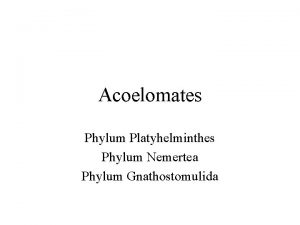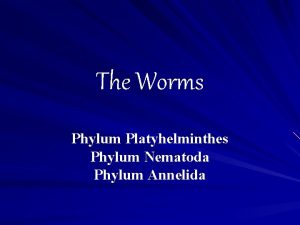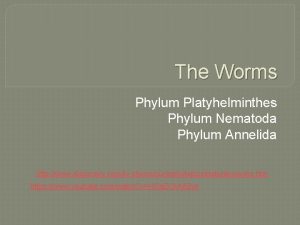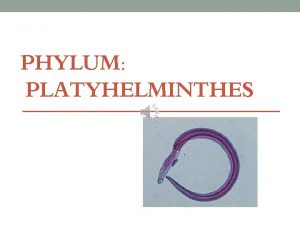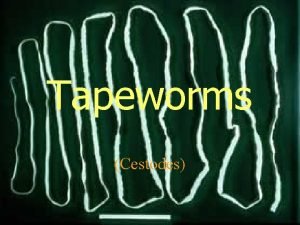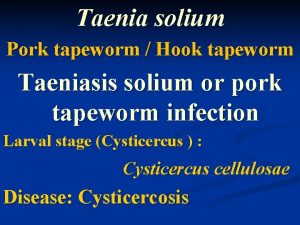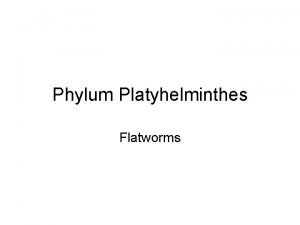Cestode tapeworm GENERAL INTRODUCTIONS Taxonomic position Phylum platyhelminthes
















































- Slides: 48

Cestode (tapeworm)

GENERAL INTRODUCTIONS • Taxonomic position Phylum platyhelminthes Class Cestoda

MORPHOLOGICAL FEATURES • Flat and Segmented • Scolex-equipped with organs of attachment: • suckers, hooks, grooves • Neck - germinal portion • germinal – development • Strobila: – Proglottids – – Immature proglottid – Mature proglottid – gravid proglottid

• Proglottids – each segment in the strobila of a tapeworm, containing a complete sexually mature reproductive system. • Gravid – carrying eggs

MORPHOLOGICAL FEATURES • Body wall: Tegument and subtegument (syncytial layer); no coelomic cavity • Monoecious

• A coelom is a cavity lined by an epithelium derived from mesoderm. Organs formed inside a coelom can freely move, grow, and develop independently of the body wall while fluid cushions and protects them from shocks


• Monoecious - (of a plant or invertebrate animal) having both the male and female reproductive organs in the same individual; hermaphrodite.

• syn·cy·tium - a single cell or cytoplasmic mass containing several nuclei, formed by fusion of cells or by division of nuclei.

PHYSIOLOGY AND PATHOGENESIS • Surface absorption capabilities • Highly developed reproductive functions • Anaerobic metabolism • All species are parasitic • Pathogenic stage may be adult or the larva

Metacestode stage • Larval stage of a cestode that develop in the intermediate host. – Cysticercus - Taenia spp. – Hydatid cyst - Echinococcus granulosus – Alveolar hydatid cyst - E. multilocularis – Cysticercoid - Hymenolepis spp.

Important species – Taenia solium – Teania saginata – Echinococcus granulosus – Spirometra mansoni – Hymenolepis nana – Hymenolepis diminuta

Taenia solium Taenia saginata

Taenia solium GENERAL INTRODUCTION • Worldwide distribution • Large tapeworm • Larval infection of Taenia solium may cause serious clinical disease ---CYSTICERCOSIS

Morphology • Can be up to 2 to 4 meters long • It has a globular scolex with four suckers and 2 circular rows of hooks (rostellum) • The gravid proglottids are 5× 10 mm with a 7 -13 branched uterus • The eggs of T. solium and T. saginata are indistinguishable

scolex of T. solium.


eggs of Taenia solium and T. saginata The eggs are rounded or subspherical, diameter 31 - 43 µm, with a thick brown embryophore. Inside each egg is an embryonated oncosphere with 6 hooks. A complete egg always has the primary membrane (shell) that surrounds eggs.


Cysticercus

• Cyticercus - a larval tapeworm that is at a stage in which the scolex is inverted in a sac, and that is typically found encysted in the muscle tissue of the host.

Life cycle of T. solium

Main points of the life cycle • Man is the only definitive host, but he can also be the intermediate host for T. solium • Pig is the important intermediate host for T. solium • Adult worm reside in the lumen of the upper part of small intestine • The infective stage to man are both egg/gravid proglottid and cysticercus for T. solium

• A tapeworm larval cyst (cysticercus) is ingested with poorly cooked rice-like meat • The larva escapes the cyst and passes to the small intestine where it attaches to the mucosa by the scolex suckers • The proglottids develop as the worm matures in 3 to 4 months

Main points of the life cycle • The adult may live in the small intestine as long as 25 years and pass gravid proglottids with the feces • When eggs consumed by pigs in which they hatch and form cysticerci • T. solium eggs can also infect humans and cause cysticercosis (larval cysts in lung, liver, eye, maxillofacial region and brain)


Pathogenesis and clinical features • Adult worm —Taeniasis – Light infections remain asymptomatic – Heavier infections may produce abdominal discomfort, epigastric pain, vomiting and diarrhea


• Metacestode stage –Cysticercosis – The cysticercus stage of T. solium can be found anywhere in the body -- subcutaneous, muscles, eye, brain – Regardless of the tissue affected, pathological consequences are those of a space-occupying lesion – Cysticerci in brain tend to grow a larger size than those in other tissues – The process of calcification may be accompanied by the release of antigens -- inflammatory reaction

Cysticercosis • The incidence of cerebral cysticercosis can be as high 1 per 1000 population and may account for up to 20% of neurological case in some countries (e. g. , Mexico); cysticercosis ocular involvement occurs in about 2. 5% of patients and muscular involvement is as high as 10% (India).

Cysticercus on the eyeground subcutaneous nodules pseudohypertrophy of muscle

Cysticerci in brain

Cysticerci in heart

Cysticerci in tongue

DIAGNOSIS • For adult worm infection (Teaniasis) * History of eating raw pork * Find gravid proglottids in feces * Perianal swab to find eggs

• For cysticercosis * Specific diagnosis is difficult to establish, the history and adult worm infection attribute to strong suspicion * Biopsy to subcutaneous lesions * Computerized axial tomography or magnetic resonance imaging * Serological examination for specific antibody

Epidemiological distribution World-wide distribution. Epidemic in central and south America (Mexico), Africa, South-east Asia, eastern Europe, Micronesia. High prevenlence Medium prevelence Low or no prevelence Epidemic limited area Data unavialable

PRINCIPLES OF CONTROL • Treat all patients to eradicate the source of larvae parasitism Pumpkin seed and areca nut ; Praziquantel • Avoid the fecal contamination of pig feed • Modernization of raising pigs • Pay attention to personal and food hygiene • Intensive examination of the pork • Adequate cooking or freezing of meat are effective precautions – cysticerci do not survive at temperatures below -10℃ and above 50 ℃.

Teania saginata v v Can be up to 4 to 8 meters long The scolex with four suckers The gravid proglottids with a 15 -30 branched uterus The eggs of T. solium and T. saginata are indistinguishable


gravid proglottid of T. solium gravid proglottid of T. saginata

LIFE CYCLE

LIFE CYCLE • Human is the only definitive host, cattle is the intermediate host • Adult worm reside in the lumen of the upper part small intestine • The infective stage to man is larva • No cysticercus in human

PATHOGENESIS • The adult parasite induces some host reaction • The process of calcification may be accompanied by the release of antigens -- inflammatory reaction

DIAGNOSIS • For adult worm infection Find gravid proglottids in feces

DISTRIBUTION • T. saginata is prevalent in regions where cattle are raised: Africa, Middle-East, Central and South America, Europe and Asia.

PRINCIPLES OF CONTROL • Treat the patients --Pumpkin seed and areca nut; Praziquantel • Modernization of raising cattle • Intensive examination of the beef

COMPARISON OF THE TWO TAPEWORMS T. solium T. saginata Size 2 -4 m 4 -8 m Scolex Rostellum & hooks No Mature Proglottid 3 lobes of ovary Gravid proglottid Intermediate Host Uterine Branches<13 2 lobes of ovary >15 Swine & Human Cattle Disease caused Infective stage Diagnosis Clinical significance Taeniasis & cysticercosis Taeniasis only Cysticercus Only Much more important Perianal egg exam Less than T. solium Chemotherapy Should be instant Not so urgent Egg & Cysticercus Egg may be found in stool
 Phylum platyhelminthes characteristics
Phylum platyhelminthes characteristics Unsegmented flat worms
Unsegmented flat worms Phylum of flukes
Phylum of flukes Metagonimus yokogawai
Metagonimus yokogawai Cestoda
Cestoda Cestode
Cestode Cestode
Cestode Cestode
Cestode Second position echappe
Second position echappe Cestodes
Cestodes Bilateria phylum
Bilateria phylum Characteristics of platyhelminthes
Characteristics of platyhelminthes Flatworm symmetry
Flatworm symmetry Platyhelminthes asexual reproduction
Platyhelminthes asexual reproduction Phylum platyhelminthes characteristics
Phylum platyhelminthes characteristics Hellmin
Hellmin Sporocyst larva classification
Sporocyst larva classification Phylum platyhelminthes
Phylum platyhelminthes Segmentation of platyhelminthes
Segmentation of platyhelminthes Platyhelminthes acoelomate
Platyhelminthes acoelomate Life cycle of taenia saginata
Life cycle of taenia saginata Example of commensalism
Example of commensalism Smallest tapeworm infecting man
Smallest tapeworm infecting man Tapeworms structure
Tapeworms structure Tapeworm fun facts
Tapeworm fun facts Hookless tapeworm
Hookless tapeworm Hookworm vs threadworm
Hookworm vs threadworm Tapeworm
Tapeworm Living organisms differ in
Living organisms differ in Taenia saginata
Taenia saginata Tapeworm adults
Tapeworm adults Uncinaria
Uncinaria Cestodia
Cestodia Flatworms
Flatworms Hymenolepis
Hymenolepis Hymenolepis nana egg
Hymenolepis nana egg Tapeworm class
Tapeworm class Beef tapeworm
Beef tapeworm Tapeworm common name
Tapeworm common name Scolex
Scolex Phylum cnidaria general characteristics
Phylum cnidaria general characteristics Monoplacophora characteristics
Monoplacophora characteristics Define heterotroph
Define heterotroph Taxonomy life's filing system answer key
Taxonomy life's filing system answer key Taxonomic kingdoms
Taxonomic kingdoms Horticulture branches
Horticulture branches Importance of microbes
Importance of microbes An example of a parallel choice on a dichotomous key is .
An example of a parallel choice on a dichotomous key is . The 8 taxonomic groups
The 8 taxonomic groups
